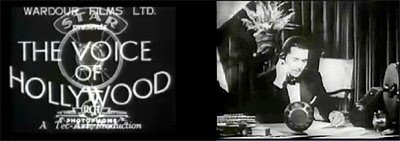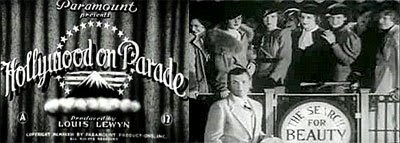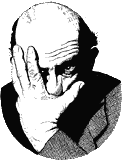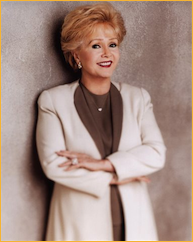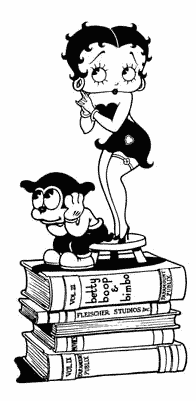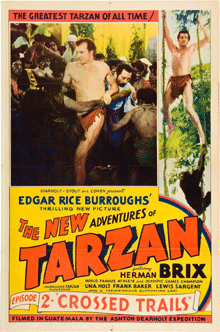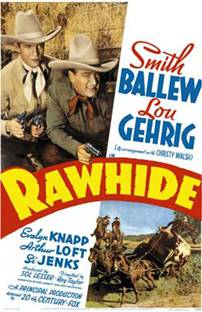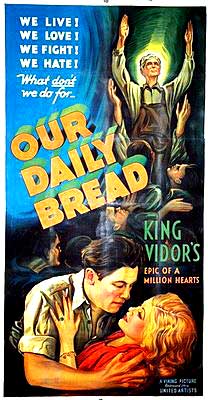Singer/songwriter/poet Leonard Cohen best sums up our continuing determination:
"Ring the Bells that still can ring
Forget your perfect offering
There is a crack in everything
That's how the light gets in."
We at Team Bijou see a crack of light in the ongoing fusion of traditional TV and computer screen content. Innovative distribution models like Netflix and the emerging Web-based networks provide fresh frontiers for the vintage film content we treasure and remain determined to widely share. In the coming New Year these new platforms provide unique opportunities for pitching both Matinee at the Bijou and The Edgar Kennedy Show.
Here is a previously published Bijou Blog post that reflects on the vintage "Hollywood Newsreel Shorts" genre, best exemplified today by TV's Entertainment Tonight:
Where on television today can you find Betty Boop, Laurel & Hardy, Our Gang or Flash Gordon? Sadly, these and countless other pre-1960 pop culture icons continue to be ignored by cable and network television gatekeepers.
A multitude of classic cartoons, short subjects and serials were last seen on our original Matinee at the Bijou series on PBS during the 1980s. Though not a prime-time show, Matinee was often rated among the top 10 shows on public television, besting such popular public television fare as Masterpiece Theater, Mystery, Frontline and Sneak Previews. Audiences loved the show and came back week after week for more.
While we remain steadfast in our search to secure a broadcast partner for the sequel series, hosted by the magnificent Debbie Reynolds, we continue to discover and secure a growing line-up of fascinating short subjects from the golden age of Hollywood, many not seen by audiences since their original theatrical releases.
The studios stopped producing short subjects altogether in the late 1950s as television became a household fixture, but in their heyday the shorts were the equivalent to what would become the sit-coms, variety shows, sports shows, cartoon series and news programs audiences could enjoy at home on the small screen.
Among our favorite theatrical shorts were the Hollywood behind-the-scenes newsreels produced during the 1930s, like The Star Reporter, Hollywood on Parade, Voice of Hollywood and Broadway Highlights. These little jewels foreshadowed today's Entertainment Tonight, Access Hollywood, American Idol and America's Got Talent TV shows.

The Star Reporter newsreels were hosted by veteran sports commentator
Ted Husing and served to introduce new and evolving talent, some going on to stardom. In one episode, 9-year old Bennie Bartlett sings his own original composition, and in another Ina Ray Hutton and Her All-Girl Orchestra let loose with some hot notes and hot moves, raising the roof until balloons descend to cover the orchestra in a grand finale.
One that was showcased on the original Matinee at the Bijou featured Dorothy Lamour's screen test, long considered lost until it surfaced in this entertaining Hollywood newsreel. The screen test proved a springboard for Lamour's career and landed her the starring role in Paramount's Jungle Princess (1936), opposite co-star Ray Milland. The marketing tagline was Her Exotic Beauty held all the allure of the tropic jungle! In spite of such corny dialogue as "You savage, untamed she-devil! I adore you!" the film made a lot of money for Paramount.
In her screen test Ms. Lamour sings a torch song that today would be considered politically incorrect in the extreme. As she lights up and smokes a cigarette she sings:
Love is like a cigarette.
You know you hold my heart
a glow between your fingertips.
And, just like a cigarette,
Love seemed to fade away
and leave behind ashes of regret.
Then with a flick of your fingertips,
it was easy for you to forget.
Oh love is like a cigarette.
On the blog screen below you can watch Ms. Lamour launch her career in this rarely-seen short from the Bijou cinematic time machine.
The Voice of Hollywood celebrity newsreels were independently produced on a shoestring budget by
Louis Lewyn for Tiffany Pictures. Each of the 26 shorts produced between 1930 and 1931 is a bizarre visual amalgamation of radio and film technologies. Each has a different celebrity host filmed talking to celebrities on the telephone or in the studio from fictitious Hollywood radio station S.T.A.R. The celebrities were often filmed paparazzi-style at a social event, sports event or movie premiere with footage then integrated into the newsreel.
These vintage treasures feature Hollywood and Broadway stars from the silent and early sound era, like Gary Cooper, Marie Dressler, Buster Keaton, Mack Sennett, Tom Mix, Thelma Todd, Johnny Mack Brown, Lupe Velez and novelty acts like Webber & Fields and Ukele Ike.
In one
Voice of Hollywood, two original members of Hal Roach's Our Gang (Little Rascals) series, Mary Kornman and Mickey Daniels, do a slapstick comedy routine wherein Mary proves she's a young feminist ahead of her time. Tom Mix drops by and actress Lupe Velez sings a song that just happens to promote her latest MGM studio release
Cuban Love Song (1931).
In another, a very young John Wayne makes a cameo appearance fresh from starring in
The Big Trail (1930), which was the first 70 mm widescreen movie ever made.
Twenty-six Hollywood on Parade shorts were produced between 1932 and 1934 and have much in common with the more primitive Voice of Hollywood series. Louis Lewyn graduated from producing the"Voice" shorts for independent Tiffany Pictures to producing and directing the "Parade" series for major studio Paramount Pictures. Television did not yet exist, so there was no Tonight Show orEntertainment Tonight where studios could otherwise cinematically promote their new big-budget releases.
Lewyn could now access Hollywood's grandest stars and biggest productions in creating his celebrity newsreels, including such luminaries as Charlie Chaplin, Jackie Cooper, Paulette Goddard, Mae West, Cary Grant, Rudy Vallee, Jean Harlow, Ginger Rogers, Jimmy Durante, Greta Garbo, Gloria Swanson, Fay Wray, Fredric March, George Burns & Gracie Allen and countless others.
In one delightful Parade entry, Bonnie Poe, as everyone's favorite vamp Betty Boop, visits a wax museum where she encounters Bela Lugosi as Dracula, who comes to life.
One of our favorite
Hollywood on Parades was inspired by Congress ratifying the repeal of Prohibition in December 1933. For one thing, it featured Bijou benefactor Rudy Vallee, who warbled our original
Matinee at the Bijou theme song. A nightclub setting on a Paramount soundstage is the locale for a mingling of celebrities and song. Cross-eyed bartender Ben Turpin is on hand to serve Jimmy Durante, Rudy Vallee and various other celebrities appearing in brief vignettes while sipping beer.
Durante needs to see a man about a dog, and his typical shtick is followed by the antics of Ted Healy and the original Three Stooges: Larry, Moe and Curly Joe. Next, Rudy Vallee arrives to mix it up and sing with songwriters Harry Revel and Mack Gordon. Revel & Mack wrote the song "Did You Ever See a Dream Walking?" and Revel gives us a taste. The songwriters perform a medley of their famous music.
Film historian and critic Leonard Maltin regards the Hollywood on Parade series to be the best of the inside-Hollywood celebrity newsreels. In his book
"Selected Short Subjects: From Spanky to The Three Stooges" he writes: "Every studio at one time or another produced behind-the-scenes shorts. The most successful were Columbia's 'Screen Snapshots,' but the best were Paramount's 'Hollywood on Parade.' Paramount's shorts stand out from the others because they are the only ones that actually seemed to shoot good, fresh material, especially for the shorts, with their top stars."

Paramount shifted focus from Hollywood to Broadway to deliver to audiences "Intimate News of the Gay White Way." Adolph Zukor assumed the helm from Louis Lewyn for the Broadway Highlights pseudo-newsreel series that began as the Hollywood on Parade series ended. Famed sportscaster-turned-showbiz impresario Ted Husing once again hosts and narrates the continuing behind-the-scenes glimpses of pop culture icons with visits to cabarets and famous entertainment landmarks.
Eight editions of Highlights were produced during 1935 and 1936. The series kicked off in May 1935 with a stellar assembly of superstars, including Jack Benny, Fanny Brice, Earl Carroll, Gary Cooper, Jack Dempsey, Al Jolson, Beatrice Lillie, Otis Skinner, Sophie Tucker, Rudy Vallee, Paul Whiteman and Walter Winchell.
One of the Broadway Highlights featured on the original Matinee at the Bijou included a visit to CBS Radio Playhouse to witness a rehearsal of "Laugh with Ken Murray," featuring a comedy routine with Eve Arden along with some swinging music from the Russ Morgan Band. Then a jaunt around the corner to the New York Winter Garden Theater to witness a tribute to the Schuberts on the 25th anniversary of the famous theater from a young Milton Berle, Bert Lahr, Phil Baker and other luminaries of the 1930s theater world. Then Ted Husing talks us across the George Washington Bridge to one of Broadway's most popular summer night spots, Ben Martin's Riviera. Highlights of the floor show included chorus girls, an incredible acrobatic dancer and some sensational moves from Spanish dancers Estelle & LeRoy.
____________________
Today we've looked at Hollywood celebrity newsreels produced during the 1930s at the outset of the sound era but there were many other notable examples released during the 1940s and 50s that we'll save for another day. In watching these remarkable films we witness the development of American popular culture and visit a world that no longer exists.
Should you or someone you know have access to film prints of celebrity newsreels, classic short subjects or serials in the public domain or for which you own the licensing rights for possible inclusion in the
Matinee at the Bijou sequel series, we'd love to hear from you. Please contact Executive Producer Ron Hall:
fesfilms@aol.com.
In the process of bringing back Matinee at the Bijou we're developing a network of film collectors, industry professionals and enthusiasts who know this history well and can share their expertise as we recreate together, in context, America's cinematic heritage.
Now, as promised, here is a fanciful example from The Star Reporter series, featuring Ted Husing and that cigarette girl ~~~






















